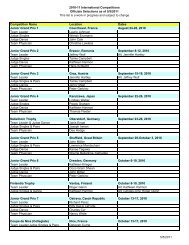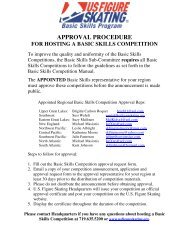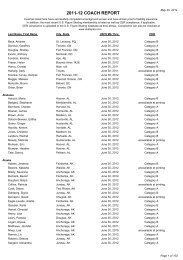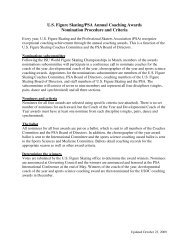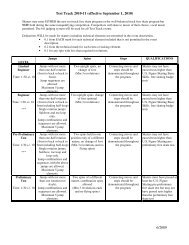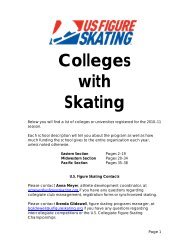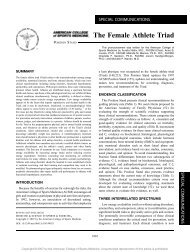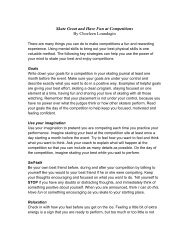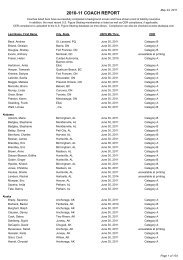2011-12 Levels of Difficulty - Pairs - US Figure Skating
2011-12 Levels of Difficulty - Pairs - US Figure Skating
2011-12 Levels of Difficulty - Pairs - US Figure Skating
You also want an ePaper? Increase the reach of your titles
YUMPU automatically turns print PDFs into web optimized ePapers that Google loves.
Twist<br />
Lifts<br />
LEVELS OF DIFFICULTY, PAIR SKATING<br />
Number <strong>of</strong> features for <strong>Levels</strong>: 2 for Level 2, 3 for Level 3, 4 for Level 4<br />
1) Lady’s split position (each leg at least 45° from the body axis)<br />
2) Catching the lady at the side <strong>of</strong> the waist without her hand(s)/arm(s)/any part <strong>of</strong> upper body touching the<br />
man<br />
3) Lady’s position in the air with arm(s) above the head (minimum one full revolution)<br />
4) Difficult take-<strong>of</strong>f (steps/skating moves executed by both partners immediately preceding take-<strong>of</strong>f)<br />
Lifts 1) Seniors: Difficult variation <strong>of</strong> the take-<strong>of</strong>f and/or difficult landing variety<br />
Juniors: Simple variation <strong>of</strong> the take-<strong>of</strong>f and/or simple landing variety (each counts as a feature)<br />
2) 1 change <strong>of</strong> hold and/or lady’s position (1 rev. before and after the change, counts twice if repeated)<br />
3) Difficult variation <strong>of</strong> the lady (one full revolution)<br />
4) Difficult (simple for juniors) carry (not for SP)<br />
5) One-hand-hold <strong>of</strong> the man (2 full revolutions in total not counting parts shorter than 1 rev.)<br />
6) Additional revolutions <strong>of</strong> the man with one-hand-hold after 2 revolutions in 5) (only in FS and only in one<br />
lift)<br />
Step<br />
Sequen<br />
ces<br />
Death<br />
Spirals<br />
Solo<br />
Spins<br />
Pair<br />
Spins<br />
7) Change <strong>of</strong> rotational direction by the man (one revolution before and after the change)<br />
1) Simple variety(Level 2), variety(<strong>Levels</strong> 3–4) <strong>of</strong> turns and steps <strong>of</strong> both partners throughout (compulsory)<br />
2) Rotations (turns, steps) in either direction (left and right) with full body rotation covering at least 1/3 <strong>of</strong> the<br />
pattern in total for each rotational direction)<br />
3) Use <strong>of</strong> upper body movements for at least ½ <strong>of</strong> the pattern<br />
4) Changes <strong>of</strong> pos. (crossing at least twice while doing steps and turns) for at least 1/3 <strong>of</strong> the sequence<br />
5) Not separating at least half <strong>of</strong> the pattern (changes <strong>of</strong> holds are allowed)<br />
1) Difficult entry (immediately preceding the death spiral) and/or exit<br />
2) Change <strong>of</strong> man’s pivot position (not for SP)<br />
3) Change <strong>of</strong> lady’s and/or man’s arm hold (1 rev. with each hold)<br />
4) Additional revolution(s) <strong>of</strong> the lady after the first revolution (counts as many times as repeated)<br />
Features 3 and 4 are counted only if both partners are in “low” positions (see Clarifications in 1611 )<br />
1) 1 difficult variation in a basic or (for spin combinations only) in an intermediate position<br />
2) Another difficult variation in a basic position which must be significantly different from the first one and:<br />
● spin in one position with change <strong>of</strong> foot – on different foot than the first one<br />
● spin combination without change <strong>of</strong> foot – in different position than the first one<br />
● spin combination with change <strong>of</strong> foot – on different foot and in different position than the first one<br />
3) Flying or backward entrance<br />
4) Clear change <strong>of</strong> edge in sit (only from backward inside to forward outside), camel, Layback and Biellmann<br />
position<br />
5) All 3 basic positions on one foot (counts twice if executed on both feet)<br />
6) 2 changes <strong>of</strong> foot (not for SP)<br />
7) Both directions immediately following each other<br />
8) At least 6 rev. without changes in pos./variation, foot and edge (camel, sit, layback, difficult upright)<br />
In any spin with change <strong>of</strong> foot the maximum number <strong>of</strong> features attained on one foot is two (2).<br />
For Spins with change <strong>of</strong> foot at least one basic position on each foot is mandatory for <strong>Levels</strong> 2 – 4 both<br />
in Short Program and in Free <strong>Skating</strong>. For spin combinations all 3 basic positions are mandatory for<br />
<strong>Levels</strong> 3-4 both in Short Program and in Free <strong>Skating</strong>.<br />
1) 2 changes <strong>of</strong> basic positions <strong>of</strong> both partners<br />
2) Additional change(s) <strong>of</strong> basic positions <strong>of</strong> both partners after the 2 changes required above<br />
3) 3 difficult variations <strong>of</strong> positions <strong>of</strong> partners, only one <strong>of</strong> which can be in intermediate position (each<br />
variation <strong>of</strong> each partner counts separately)<br />
4) Any other difficult variation(s) <strong>of</strong> positions <strong>of</strong> partners in addition to the 3 variations required above (each<br />
partner must have at least one difficult variation)<br />
5) Entrance from backward outside or inside edge<br />
6) Both directions immediately following each other<br />
7) At least 6 revolutions without any changes in position/variation and foot (camel, sit, difficult upright)<br />
5
6<br />
Clarifications<br />
Clarifications published in the ISU Communication 1611 should be amended as follows:<br />
Step Sequences (Singles and <strong>Pairs</strong>): Use <strong>of</strong> upper body movements means the visible use for a combined<br />
total <strong>of</strong> at least 1/2 <strong>of</strong> the pattern <strong>of</strong> the step sequence any movements <strong>of</strong> the arms, head and torso that<br />
have an effect on the balance <strong>of</strong> the main body core.<br />
Singles: Two combinations <strong>of</strong> difficult turns are considered to be the same if they consist <strong>of</strong> the same<br />
turns done in the same order and on the same edges.<br />
Spins (Singles): Backward and flying entry, change <strong>of</strong> edge and any type <strong>of</strong> difficult spin variation count<br />
as features that can increase the Level only once per program (in the first spin they are attempted).<br />
Normal flying camel entry does not count as a Level feature, but counts as such an attempt.<br />
Lifts: Landing on the other foot is not automatically considered as a simple landing variety. Inside Axel<br />
take-<strong>of</strong>f in 5ALi and 5SLi is considered as a difficult variation <strong>of</strong> the take-<strong>of</strong>f.<br />
Pair spins: execution <strong>of</strong> 4 difficult variations (each variation <strong>of</strong> each partner counted separately)<br />
will result in 2 Level features independent on the order <strong>of</strong> these variations if at least 2 <strong>of</strong> these<br />
variations are executed in basic positions and each partner has at least 1 variation.<br />
Death Spirals: Difficult entry to a death spiral should be on the curve and on the leg <strong>of</strong> the death spiral<br />
and while acquiring the actual death spiral position there should be a continuous and not too prolonged<br />
movement to this position.<br />
If during the Death Spiral Lady’s head never reaches the level <strong>of</strong> her skating knee, the Death Spiral will<br />
have no value.<br />
V. Additional remarks<br />
1. The abbreviation LSp indicates not only the Layback, but also the Sideways Leaning Spin.<br />
2. The Single and Pair Technical Committee reminds the Judges <strong>of</strong> the necessary GOE reduction in<br />
case steps and/or movements do not immediately precede the jump in the Short Program. In case <strong>of</strong><br />
steps the take-<strong>of</strong>f <strong>of</strong> the jump must be in the rhythm <strong>of</strong> these steps.<br />
Milan, Ottavio Cinquanta, President<br />
May 5, <strong>2011</strong><br />
Lausanne Fredi Schmid, Director General





